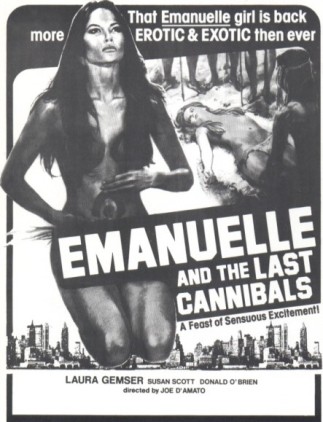When the horror compilation Terror in the Aisles proved to be an unexpected theatrical hit in 1984, it was unsurprising that several imitations sprung up, and this 1985 British production is probably the most disreputable of them all – quite an achievement in a world where Terror on Tape exists!
Produced by the infamous Dick Randall and Steve Minasian, the film is directed – if that is the word to use – by Ray Selfe, a veteran of the British sex film (hardcore and softcore) and more recently a film archivist who curates a vast collection of public domain material. Some of that turns up here, but mostly it’s a mix of Randall and Minasian productions / acquisitions and films that have almost certainly not been copyright cleared.
What imitations like this fail to understand about why Terror in the Aisles worked is because it wasn’t just a random selection of clips – instead, the film skilfully intercut scenes from several movies, using an original score, to help build a sense of tension. It also worked as a study (however basic) of the genre. This film, however, is too scattershot and messy, and simply presents rather lengthy clips from assorted films with little or no context.
For his linking scenes Price sits on a throne in a black room, as the camera zooms in and out wildly, introducing a series of clips that often have only the slightest connection to what he’s saying. “These days, special effects are much more believable” says Price at one point, as the film cuts to the ludicrous ‘flying head’ scene from Indonesian supernatural shocker Queen of Black Magic.
Christopher Lee is cheekily made to seem like a co-narrator, thanks to randomly selected clips from the 1975 documentary In Search of Dracula. “Here’s Christopher Lee”, says Price as though he’s a news anchor handing over to a reporter, and we get a couple of scenes that appear to have been taken from different prints of the movie. Price tries a similar schtick by having ‘conversations’ with Boris Karloff, courtesy of Black Sabbath clips.
The editing is terrible – we often cut back to Price when he’s mid-word. The sourced clips are in various aspect ratio, meaning that the 4:3 film frequently has heavily letterboxed scenes, and they vary in quality too.
So what does this badly edited, shoddily produced rip-off have going for it? Well, sex and violence, mainly. If you fancy Randall’s Don’t Open Till Christmas but are unsure about sitting through the whole thing, this is the movie for you, as all the best bits are compiled into one digestible chunk (and the footage here is actually much better than most versions of the film currently circulating), and you’ll get to enjoy the legendary “chainsaw elevator” scene from Pieces again.There are nasty bits from Slaughter High, Mark of the Devil, Last Cannibal World, Bay of Blood and Mother’s Day, as well as clips from Cannibal Man, Friday 13th 1 and 2, Crocodile and Tombs of the Blind Dead. Most of the clips seem to have been selected on the sound basis of how much nudity and gore they contain.
But also thrown in are scenes from Devil Bat, The Lost World, the silent Phantom of the Opera, White Zombie, Scars of Dracula (the blood puking bat!), Nosferatu, The Thirteenth Guest, Who Killed Doc Robbin and The Ape, presumably because they are either public domain or taken from copyright-free trailers. Most bizarrely, there are clips from Paul Hart-Wilden’s short Horror Film.
Trashy as this outrageous scam is, there’s no questioning that it’s an amusing time waster. Perhaps inevitably, it was never commercially released but is now available via Youtube.
DF







































































































































































































